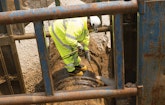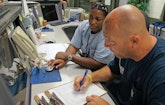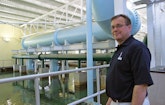Interested in Manholes?
Get Manholes articles, news and videos right in your inbox! Sign up now.
Manholes + Get AlertsFor a decade and a half, Louisville Water Co. invested between $8 and $10 million a year cleaning, relining or replacing old pipe responsible for scores of water main breaks that challenged the system and its customers.
Those efforts paid off in a steep reduction in wasted time and money fixing broken mains. But that was “low-hanging fruit,” says Keith Coombs, manager of infrastructure planning for Louisville Water. So for the last six years or so, the utility has been aiming a lot higher.
Through a mix of inspection, cleaning, and continued repair and replacement efforts, Louisville Water is striving to achieve the best bang for its buck in ensuring the continuous improvement of its water distribution system.
And it is doing so while grappling with declining per capita water consumption at the same time its customer base is growing. So even though water revenues aren’t going up by much, the utility continues to see a growing need for more water distribution infrastructure to meet the needs of an expanding metropolitan area.
Those and other forces all make optimizing the existing infrastructure even more important. And part of that is knowing when to replace lines and when to opt instead to preserve them through close inspection, cleaning and relining.
“Our selection criteria has evolved,” says Coombs. “It’s a lot more sophisticated.”
Private company
Louisville Water started out as a private company, says strategic communication manager Kelley Dearing Smith. That was in 1854. It never got very much investor interest however, and by 1906 the city of Louisville had become the sole owner by buying all of the water company’s stock.
Today, Louisville Water serves a total of 850,000 people through about 285,000 business and residential connections in the Louisville metro area via more than 4,000 miles of pipe.
As the only shareholder, the city is paid annual dividends from the operation’s profits; it also gets its water free, as does the Louisville Fire Department. Between dividends and the free water, the deal is worth about $38 million a year to the city, says Dearing Smith.
Meanwhile, the other half of the Louisville Water Co. profit is invested right back into the water system’s assets, infrastructure and capital programs. Those have become increasingly important priorities over the last couple decades.
Systematic maintenance
Repeated water main breaks, especially in cold weather, taxed the operation over the last few decades, so in 1992 the utility hired a consultant to get to the bottom of the problem and help establish a systematic program for inspection and repairs.
What followed was a focus on 12-inch-diameter and smaller mains. One type of cast-iron pipe made with the so-called deVaud process, which was installed from about 1925 to 1932, “was especially prone to circumferential failures,” says Coombs — particularly in winter.
“It was not unusual to have 30 to 40 breaks a day during that winter period.”
Replacing that pipe became top priority. At the same time, Louisville Water embarked on a program of scraping out functioning cast-iron mains that had become impaired by tuberculation from rust buildup. Some of those mains were so clogged their effective diameter was reduced to 2 to 3 inches. Once those pipes were cleaned out, crews sprayed a cement lining on the inside to prevent more rust.
From 1992 to about 2007, “We spent $120 million devoted to basically rehabbing a good portion of our system,” Coombs says.
Net present value
Once the easy targets were taken care of, though, a more analytical approach became necessary. Louisville Water carefully evaluates the “net present value” of repair versus replacement for a failed pipe.
If a pipe can be repaired inexpensively, with little disruption to the community, repair may be preferable, Coombs explains. An example might be a distribution main located out of the way that can be fixed simply by putting a steel band around the cracked pipe at a cost of perhaps a thousand dollars or so. Even if future repairs are needed, they’re likely to be inexpensive and to create little disruption when compared with replacing the line.
The other extreme might be a pipe that runs under a major roadway. Whether repaired or replaced, fixing the problem will mean disrupting traffic and possibly tearing up roadway that will have to be repaved. “It’s slow, tedious work,” Coombs says. “It’s not uncommon for those to cost $40,000 a break.” In those situations, a full-blown replacement is likely to be more cost-effective, considering the risk that a repair might fail and have to be repeated.
Factors include how many customers are affected when the pipe fails, what sort of impact repair versus replacement has on people using the community’s roadways and the level of risk of a repeat failure if the pipe isn’t replaced. The potential need for future repairs is based on information such as soil corrosivity and whether repair tickets on the line indicate a lot of external corrosion already. The question of whether the main itself is undersized and should be replaced for that reason alone also is taken into account.
“Instead of attacking a particular class or vintage of pipe now, we’re looking to manage breaks from an economic standpoint,” Coombs says.
Transmission lines
At the same time, Louisville Water is also taking a close look at its transmission lines, which are considerably larger than the distribution lines and range from 24 to 72 inches in diameter.
That requires a different approach. While there are 3,900 miles of distribution lines, there are 200 miles of the larger transmission lines.
“We’re really trying to manage the smaller pipe failures to a reasonable level,” says Coombs. “We’re not going to be able to eliminate those. There are orders of magnitude of difference between a distribution failure, which might cost a few thousand bucks to repair, and a transmission line failure, which can cost millions of dollars to repair — through damage claims, the actual repair costs and restoration costs. We are trying to be more proactive with our transmission main system.”
About half of the utility’s transmission mains are prestressed concrete cylinder pipe — a steel pipe, lined on the inside and coated on the outside with concrete, with prestressing steel wires embedded in the outer concrete shell.
PCCP is generally strong and durable, but it can sometimes fail, says Coombs. Usually that happens when the concrete gets compromised, such as when cracks allow water to seep in and rust the steel wires that are supposed to enhance its durability. If they rust enough that they start breaking, that can then lead to damage to the steel and concrete components as well, increasing the risk of failure.
In 2009, Louisville Water saw one such pipe fail. Coombs says the utility got lucky. “It occurred at a great location — the water was able to get away. There was minimal property damage, and it wasn’t at a real high demand period,” he says. There was also a backup line that could be easily put into service until the damaged line was repaired.
But that was a wake-up call. “Had it broken 2,000 feet down the line, the cost of that would probably have been $10 million,” he says. “We considered ourselves very fortunate.”
Systematic inspection
Louisville Water is now spending about $2 to $3 million a year to check those PCCP lines, doing about 8 to 10 miles a year. The project is expected to be complete by 2019. While somewhere from 2 to 4 percent of the PCCP lines may have some damage, less than 1 percent will actually need to be fixed or replaced, says Coombs. But if it can be handled before failing, the cost is going to be much less, both in property damage and because less pipe will need to be fixed — once a pipe fails, it typically damages additional pipe that connects to it.
The utility has various tools for identifying problem pipes. When a line cannot be taken out of service, crews can send in a PipeDiver from Pure Technologies, which uses electromagnetic sensors to detect problem wires in the pipe.
Robotic units carrying cameras mounted on them can be used in water mains that can be taken out of service for the inspection, and in some mains that are big enough, workers may go through pipes themselves with inspection equipment.
If repair is called for, there are a variety of options, including wrapping the line in steel, putting tension cables around it or even mending it with high-tech carbon fiber — the same material being used in everything from bicycles to aircraft.
Louisville Water is in the process of evaluating various repair methods to develop criteria for which ones best suit specific circumstances.
The utility is also exploring ways to better assess the quality of conventional ductile iron pipe, Coombs says.
Economic challenges
All this is happening even as Louisville Water faces two seemingly contradictory trends: less water use — meaning tighter revenue — and expanding demand for water distribution infrastructure.
Over the last 20 years or so, the utility has lost about half of its industrial customers. “And the ones that have stayed with us have drastically decreased the amount of water they’re using,” Coombs says. And while the residential and commercial customer base is growing modestly, individual usage is falling, thanks to trends such as smaller families and the use of water-saving fixtures in homes and businesses.
So while the number of accounts grows at about 2 to 3 percent a year, that’s offset by the diminishing individual usage. Yet, Coombs notes, “We still have to maintain pump systems and distribution systems.” Having to maintain the extensive base of assets means that even though usage is falling, water rates may creep up to cover costs that continue to increase.
Those trends make it even more important to get the most out of the assets that Louisville Water has and to make repairs more effective and less expensive.
“We’re trying to be proactive with our transmission main assessment work to ultimately prevent a failure,” Coombs says. “When those pipes go, it is on the news. It is a big event. There’s a big impact on customers; there’s a lot of property damage. It’s just not a very good day.”
But by stepping up now to solve problems before they happen, Louisville Water’s personnel hope to make the good days happen a lot more often, and keep the not-so-good ones to a minimum.











